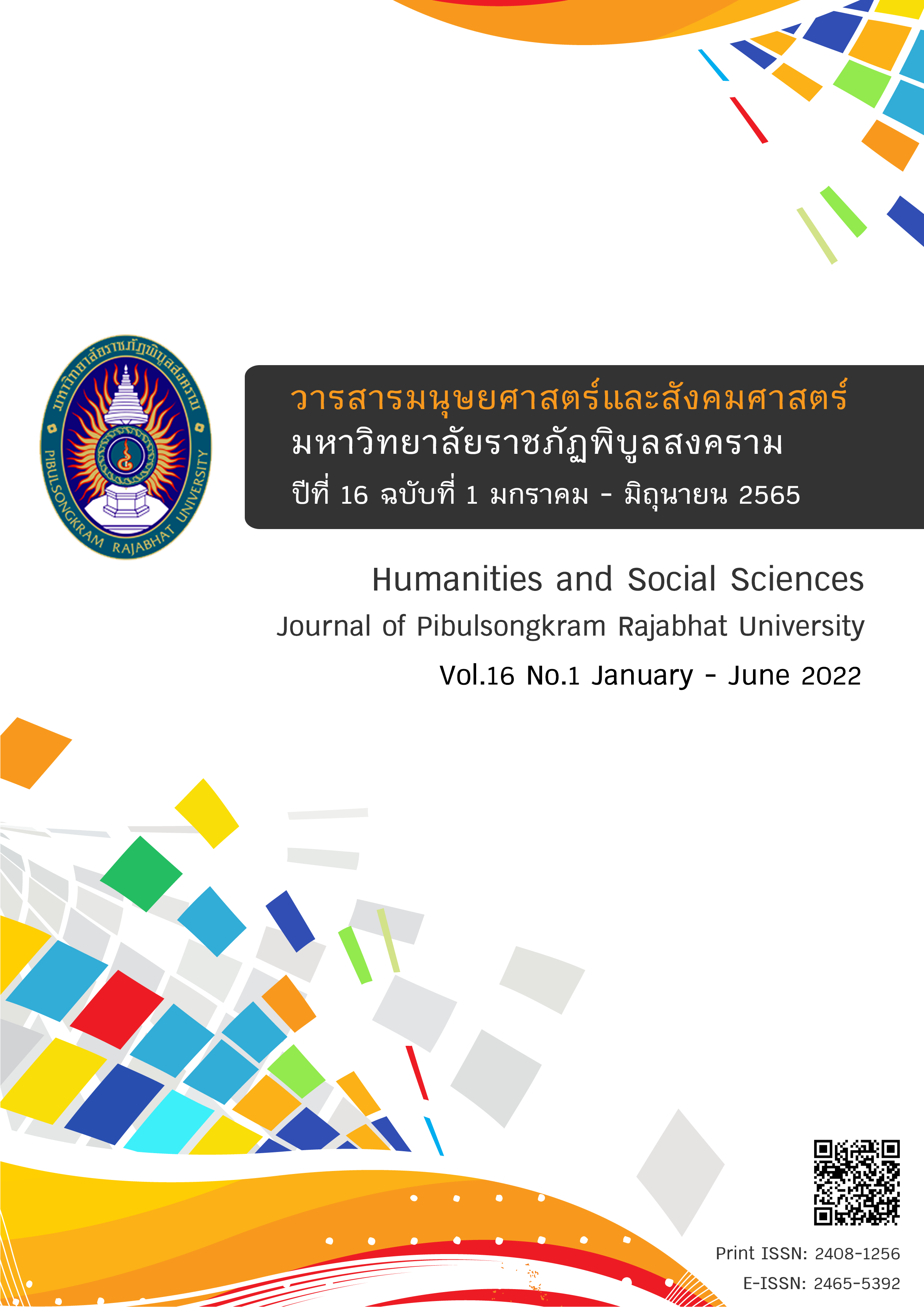The Innovative Management Model for Enhancing the Effectiveness of the Herbal City under the National Master Plan for Thai Herb Development
DOI:
https://doi.org/10.14456/psruhss.2022.27Keywords:
Management innovation, Herbal city, Effectiveness of the herbal cityAbstract
The development of a herbal city requires the knowledge of management innovation knowledge as well as human capital and organization management, together with the application of modern technology in the production process. These factors enable the herbal products to be developed to meet the needs of the market and consumers and enjoy competitive potentials. The objectives of this research were to 1) study the levels of management innovation, human capital and organization management, ecological management system, and effectiveness of the herbal city under the National Master Plan for Thai Herb Development; 2) study the influences of management innovation, human capital and organization management and ecological management system on the effectiveness of the herbal city under the National Master Plan for Thai Herb Development; and 3) develop a management innovation model for enhancing the effectiveness of the herbal city under the National Master Plan for Thai Herb Development. This research employed a mixed research methodology combining quantitative and qualitative methods. The sample consisted of 280 executives and officers working in the herbal city at the provincial level and Thai herb entrepreneurs in the quantitative research part. They were selected via stratified sampling. The sample size was determined based on the 20 times the observed variables. Data were collected with the use of a questionnaire and analyzed with a structural equation model. In the qualitative research component, in-depth interviews were conducted with 17 key informants who were experts whose works related to the National Master Plan for Thai Herb Development. They were selected via purposive sampling. Data were analyzed with content analysis. The research findings showed that: 1) management innovation and ecological management were rated at a moderate level whereas human capital and organization management were at a high level; 2) management innovation, human capital and organization management, and ecological management system had an influence on the effectiveness of the herbal city at a .05 level of statistical significance, and these factors could predict the effectiveness of the herbal city by 87 percent; and 3) the management innovation model for enhancing the effectiveness of the herbal city developed by the researcher focused on the principle strategies which included the innovation of herbal products based on local wisdom or producing the products by using the local herbs in development of products that did not affect the environment, and the farming of herbs that were free from chemicals. In terms of quality and incorporating the complete loop in the global market, entrepreneurs needed to develop innovations and grow herbs that have consistent quality and cover the complete supply chain. In addition, the development of the herbal city needed to integrate from all sectors including the government sector, private sector, and communities to continuously increase the economic value. This management innovation model can be used as the guidelines for the efficient development of the herbal city and the enhancement of its global competitive advantage on a global scale.
References
กระทรวงสาธารณสุข. (2559). แผนแม่บทแห่งชาติว่าด้วยการพัฒนาสมุนไพรไทย ฉบับที่ 1 พ.ศ. 2560-2564. กรุงเทพฯ: สถาบันวิจัยระบบสาธารณสุข กรมพัฒนาการแพทย์แผนไทยและการแพทย์ทางเลือก.
ดนยา ทองสิมา. (2549). กลยุทธ์นวัตกรรมทางการตลาดสำหรับผู้ส่งออกสินค้าอาหารแห้งของไทย (ดุษฎีนิพนธ์ปรัชญาดุษฎีบัณฑิต). กรุงเทพฯ: มหาวิทยาลัยราชภัฏสวนดุสิต.
ธนภัท แสงอรุณ, และฝ้ายคำ ถิรพร. (2557). การสร้างโซ่อุปทานระหว่างประเทศสำหรับสถาบันเกษตรกรไทย: ศึกษาเฉพาะผลิตภัณฑ์สมุนไพร (รายงานการวิจัย). กรุงเทพฯ: สํานักงานคณะกรรมการส่งเสริมวิทยาศาสตร์ วิจัยและนวัตกรรม.
นพดล เหลืองภิรมย์. (2550) การจัดการนวัตกรรม : การพัฒนาตัวแบบความสามารถ ในการสร้างสรรค์นวัตกรรมของนักวิจัย (ดุษฎีนิพนธ์ปรัชญาดุษฎีบัณฑิต). กรุงเทพฯ: มหาวิทยาลัยรามคำแหง.
นิลาวัลย์ สว่างรัตน์. (2558). อิทธิพลเชิงโครงสร้างของความเป็นผู้ประกอบการ การมุ่งเน้นการตลาดการมุ่งเน้นนวัตกรรม และการมุ่งเน้นการเรียนรู้ ที่มีต่อผลการดำเนินงานขององค์การ. Veridian E-Journal, Silpakorn University, 8(3), 958-975.
บุญฑวรรณ วิงวอน, ชัยยุทธ เลิศพาชิน, และขจรศักดิ์ วงศ์วิราช. (2554). การจัดการห่วงโซ่อุปทานของวิสาหกิจชุมชนกลุ่มผักปลอดสารพิษของ อำเภอห้างฉัตร จังหวัดลำปาง. ใน การประชุมวิชาการและนำเสนอผลงานวิจัยระดับชาติ “แม่โจ้-แพร่ วิจัย ครั้งที่ 2”. แพร่: มหาวิทยาลัยแม่โจ้-แพร่ เฉลิมพระเกียรติ.
พยัต วุฒิรงค์ (2557). การจัดการนวัตกรรม : ทรัพยากร องค์การแห่งการเรียนรู้ และนวัตกรรม. กรุงเทพฯ: จุฬาลงกรณ์มหาวิทยาลัย.
สุนันทา เสถียรมาศ. (2555). นวัตกรรมการจัดการที่ส่งผลต่อความสำเร็จของวิสาหกิจขนาดกลางและขนาดย่อมที่ได้รับรางวัลดีเด่นของไทย (ดุษฎีนิพนธ์ปรัชญาดุษฎีบัณฑิต). กรุงเทพฯ: มหาวิทยาลัยราชภัฏสวนสุนันทา.
Buffington, J. (2010). Product design and supply chain fulfillment through a generative customization solution to achieve discontinuous innovation (Doctoral dissertation). Luleå tekniska universitet.
Deutsch, L. (2004). Global trade, food production and ecosystem support: Making the interactions visible (Doctoral dissertation). Institutionen för systemekologi.
Ding, L., Velicer, W. F., & Harlow, L. L. (1995). Effects of estimation methods, number of indicators per factor, and improper solutions on structural equation modeling fit indices. Structural Equation Modeling: A Multidisciplinary Journal, 2(2), 119-143.
Euromonitor International. (2016). Natural Healing and Prevention: Renewed Perspectives on Herbal and Traditional Products. Retrieved September 15, 2020, from https://1bestlinks.net/uEt9W
Fondas, N. (1993). [Review of Process Innovation: Reengineering Work through Information Technology, by T. H. Davenport]. The Academy of Management Executive (1993-2005), 7(2), 100–103. http://www.jstor.org/stable/4165128
Hair, J. F., Black, W. C., Babin, B. J., Anderson, R. E., & Tatham, R. L. (2006). Multivariate Data Analysis: Pearson Prentice Hall. Upper Saddle River, NJ, 1-816.
Kline, R. B. (2005). Principles and Practice of Structural Equation Modeling (2nd ed.). New York: Guilford.
Lim, H. (2008). SMEs Development policy environment and challenges in Singapore. Singapore: Singapore Institute For International Affairs.
Na, J. H. (2016). A study of design innovation framework for innovative manufacturing companies in the UK (Doctoral dissertation). Brunel University London.
Radicic, D. (2014). The Effectiveness of R&D and Innovation Policy in Promoting Innovation in European SMEs: an Empirical Investigation of Additionality Effects: A thesis submitted in partial fulfilment of the requirement of Staffordshire University for the degree of Doctor of Philosophy (Doctoral dissertation). Staffordshire University.
Vongpivat, P. (2002). A national innovation system model: Industrial development in Thailand. Fletcher School of Law and Diplomacy (Tufts University).
Downloads
Published
How to Cite
Issue
Section
License
Copyright (c) 2020 Humanities and Social Sciences Journal of Graduate School, Pibulsongkram Rajabhat University

This work is licensed under a Creative Commons Attribution-NonCommercial-NoDerivatives 4.0 International License.
Any articles or comments appearing in the Journal of Humanities and Social Sciences, Rajabhat Phibulsongkram University, are the intellectual property of the authors, and do not necessarily reflect the views of the editorial board. Published articles are copyrighted by the Journal of Humanities and Social Sciences, Rajabhat Phibulsongkram University.









